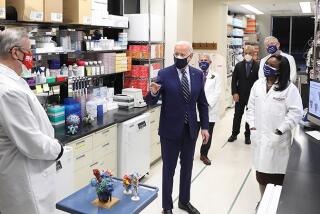Patent Ruling Will Be Crucial for Drug Maker : Biotechnology: Amgen Inc. could face huge damages over its medicine for kidney disease. But the Thousand Oaks company also has a second potential blockbuster product on deck.
- Share via
Amgen Inc. has only one product to sell, but when it’s the latest biotechnology blockbuster drug one can be enough. Called erythropoietin, or EPO, it knocks out chronic anemia in patients with kidney disease, and like insulin for diabetics, EPO is their only medical treatment.
The drug’s success has vaulted the Thousand Oaks company to the top tier of the biotechnology industry. At the moment Amgen enjoys a monopoly on a $300-million-a-year business in the U.S., while EPO profits pile up at the rate of nearly $50 million annually. While Wall Street has stumbled this year, Amgen’s stock has more than doubled. On deck Amgen has a second drug designed to help cancer patients fight off infections that analysts say will be an even bigger winner than its first drug.
Is there anything wrong with this cheery diagnosis? Maybe so.
In the next month or two a federal appeals court in Washington should release its decision on a critical case involving rival EPO patents held by Amgen and Genetics Institute, a Cambridge, Mass., concern. The court decision could secure the EPO market for Amgen, Amgen could lose its rights to the drug or, as most analysts expect, the court could effectively force Amgen to share the EPO business and leave it vulnerable to a hefty damages suit.
Jeffrey R. Swarz, an analyst with the investment firm Goldman, Sachs & Co., said that if the appeals court upholds both EPO patents, Genetics Institute will promptly sue Amgen for “past and present damages in excess of $100 million.” Jim McCamant, editor of the Medical Technology Stock Letter in Berkeley, expects the court decision to go against Amgen and to knock 20% off Amgen’s stock price.
Amgen must also fret about damages that it may have to pay a Johnson & Johnson subsidiary, which helped fund Amgen’s EPO research and owns the rights to sell the drug for all other anemia treatments except severe kidney disease. J&J; claims that it was deprived of profits because Amgen botched its chances for quick government approval to sell the drug, and now a Chicago arbitration judge is reviewing the case. Swarz believes that “J&J; has asked for very significant damages of between $100 million and $200 million.”
Swarz said that “in a worst-case scenario Amgen may be looking at $300 million in damages” to settle both EPO cases. Granted, Swarz and other analysts said the final financial damage to Amgen should be much less. But for now the only certainty is uncertainty.
Biotechnology is the science of resplicing genes, which contain the hereditary instructions for life, so that cells can be “engineered” to keep copying, or cloning, substances that can be used as new drugs. For years outsiders have urged Amgen to settle its EPO suits rather than risk its fortunes on courts that may not understand all the subtleties of the science. “It would have been very practical to settle,” Swarz said.
“If you don’t defend your patents, it’s the same as having no patents,” barked Amgen’s chief executive, Gordon Binder. “Nobody else is going to defend your patents. Not the FBI, not the Highway Patrol. A company that doesn’t defend its patents is on the way to going out of business.”
But last December a court in Boston ruled that both Amgen and Genetics Institute held valid EPO patents.
Genetics Institute licensed its EPO drug to a joint venture between Chugai Pharmaceutical, a major Japanese drug company, and Upjohn Co., the Kalamazoo, Mich., pharmaceutical powerhouse. Chugai-Upjohn has been trying to catch Amgen since June, 1989, when the Food and Drug Administration gave Amgen the go-ahead to sell its anti-anemia drug. Chugai-Upjohn was thought to be only a few months from winning government approval to sell its EPO drug, but there is widespread speculation that the FDA doesn’t want to rule on the Chugai-Upjohn drug until the patent case is settled.
Final settlement of the EPO case is “years away,” warned Vector Securities analyst Peter Drake. He likens the pitched battle to the 14-year-old Kodak-Polaroid battle over instant cameras, in which Polaroid’s patents were upheld by the courts although Kodak has yet to pay out any damages. Meanwhile, time is money for Amgen, he said. The longer Amgen keeps the EPO market to itself, he said, the more likely it will still dominate the business whenever competition is finally allowed.
Analyst David Stone of Cowen & Co., a former product manager for Genetics Institute, thinks the EPO case will probably be settled with Amgen agreeing to a cross-licensing deal, perhaps paying 10% of its EPO sales to Genetics Institute. He said it might cost Amgen $100 million to settle all of its EPO litigation; that sum works out to a present-day value of about $2 per share of Amgen’s stock, he said. On Monday, Amgen’s stock closed at $54.625. “Amgen has played a high-risk strategy. If it ends up costing them $2 a share, they’ve won,” Stone said.
Erythropoietin is a protein in the blood stream that spurs production of red blood cells, which transport oxygen throughout the body. EPO was discovered by scientists in 1906, but it occurs in the body in such tiny concentrations that until biotechnology there was no way to use it as a drug. Then an Amgen scientist found the gene that triggers production of EPO, and by splicing that gene with some Chinese hamster cells it created a mini-cell factory that keeps reproducing EPO.
About 72,000 patients now take the drug, including John Cole, 41, editor of a newspaper in Lorain, Ohio. Ten years ago he had a kidney transplant but when his new kidney failed, Cole needed kidney dialysis treatments, plus weekly blood transfusions that left him worrying about getting AIDS or hepatitis from tainted blood supplies.
Cole forced himself to work each day, “but that was it. I’d go home and just taking out the trash was a laborious experience. It was just a feeling of pure exhaustion.”
Four years ago as “a guinea pig” in Amgen’s test of the new drug, he felt his “energy level surge,” he said. He’s been on EPO ever since. Cole still needs dialysis treatments, but he has yet to have another blood transfusion. He puts in 50 hours a week on his job and now “I have the energy to do whatever I want afterwards,” Cole said. So he works out in a gym, lifts weights and bicycles. “The drug is one of the most important things that ever happened to me,” he said.
It’s the sort of story that has made EPO worth fighting over. Amgen and Genetics Institute hold much different patents on EPO. Amgen’s patent covers part of the biotechnology process for making EPO, while Genetics Institute’s patent covers a purified form of EPO that was separated from urine. Although Genetics Institute’s method isn’t practical--it can’t produce enough this way--the protein is similar to what is manufactured in a lab (the company’s scientists later figured out how to make EPO using biotechnology).
Amgen’s next drug is granulocyte colony stimulating-factor, or G-CSF, which spurs the production of white blood cells that fight off bacterial infections. FDA approval is expected in a few months and G-CSF has the look of another winner because in tests it has helped cancer chemotherapy patients ward off infections.
Binder said that “in the long run” G-CSF should be an even bigger success for Amgen than EPO. Two weeks ago, Amgen agreed to pay $50 million to its research partner, Memorial Sloan-Kettering Cancer Center in New York, to keep more of the G-CSF royalties for itself over the next 15 years.
There will be, however, other white blood cell drugs. Immunex, a Seattle biotechnology firm, soon will begin selling a drug called GM-CSF that looks useful in treating burn patients or bone marrow transplants.
But the New England Journal of Medicine reports that G-CSF seems to have fewer side effects than GM-CSF, and as Drake pointed out, there are many more cancer chemotherapy patients than bone marrow transplants. So Drake expects Amgen’s take from G-CSF sales in five years to be $450 million a year.
Meanwhile, Amgen has a patent on the new drug and its closest rival, old foe Chugai, is probably several years away from selling G-CSF here, McCamant said.
Maybe then Amgen won’t have to suffer through another legal marathon over G-CSF. But don’t bet on it, Drake said. Chugai and Amgen’s attorneys figure to cross swords over this drug as well. The biotechnology business, he said, “is really a full employment act for lawyers.”
More to Read
Inside the business of entertainment
The Wide Shot brings you news, analysis and insights on everything from streaming wars to production — and what it all means for the future.
You may occasionally receive promotional content from the Los Angeles Times.











